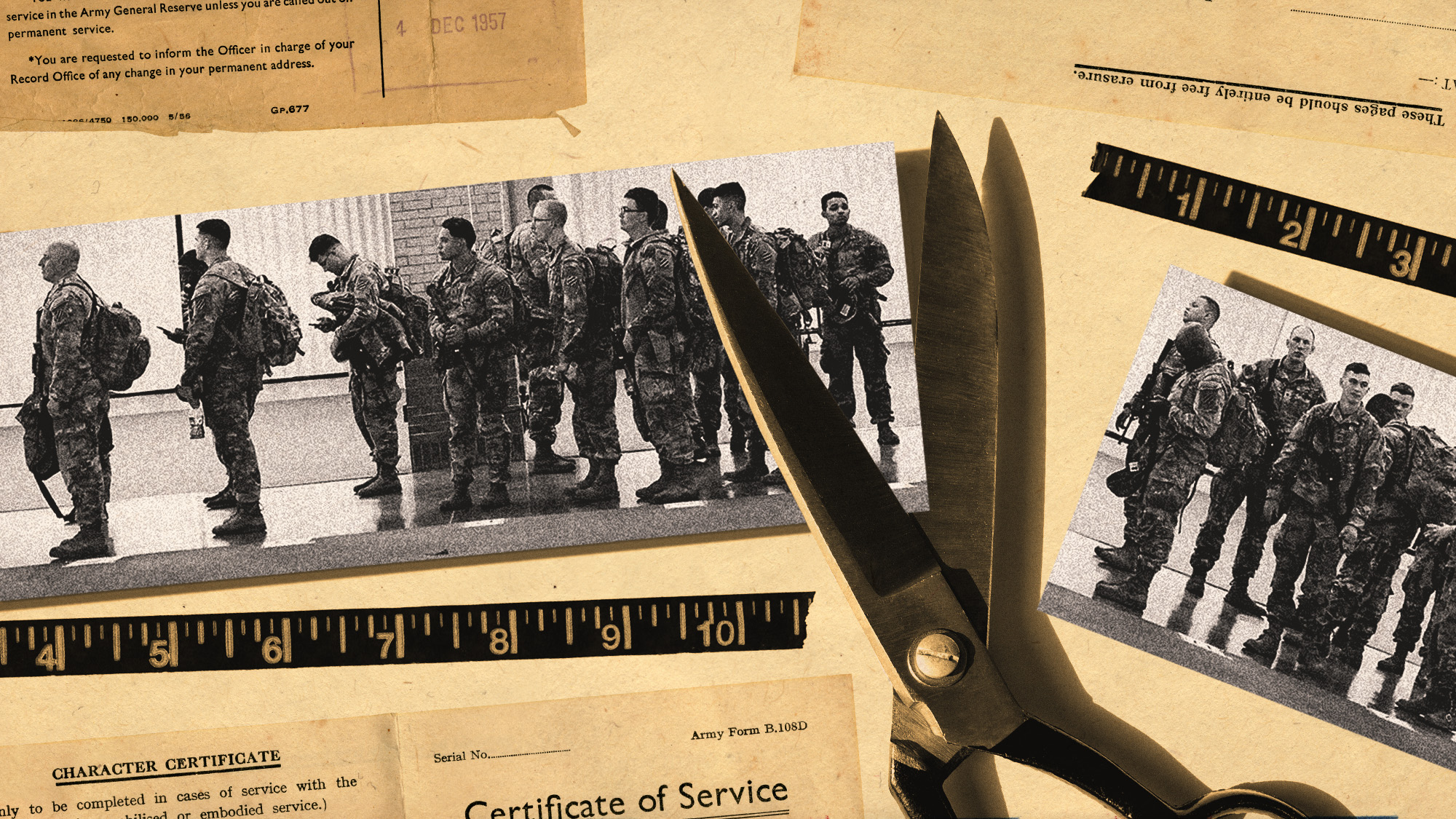The US Army is revamping itself — by cutting jobs
The revamp is part of a strategy to deal with Chinese and Russian aggression


The United States Army is beginning to implement a new strategy for the future of American defense, but it's doing so through an unconventional method — by slashing thousands of jobs.
Internal documents show that the Army is planning to cut about 24,000 positions from its ranks, according to The Associated Press. The cuts will mainly occur in "already empty posts — not actual soldiers — including in jobs related to counterinsurgency that swelled during the Iraq and Afghanistan wars but are not needed as much today," the AP said. At the same time, the Army is reportedly planning to add "about 7,500 troops in other critical missions, including air-defense and counter-drone units," said the AP.
But while many of these jobs were already vacant, the slashing sheds light on the well-documented problems with recruiting that have plagued the Army. They are also in line, though, with plans to try and beef up U.S. defenses against China and Russia. But how will this job restructuring help the Army prepare for potential wars in the future?
The Week
Escape your echo chamber. Get the facts behind the news, plus analysis from multiple perspectives.

Sign up for The Week's Free Newsletters
From our morning news briefing to a weekly Good News Newsletter, get the best of The Week delivered directly to your inbox.
From our morning news briefing to a weekly Good News Newsletter, get the best of The Week delivered directly to your inbox.
What is the Army's restructuring plan?
The Army's plan for retooling is part of a "rigorous assessment of its force structure" that the U.S. military has undertaken, according to an Army document of the plan. The document describes the Army as "significantly over-structured," which means that it "lacks the number of necessary soldiers to fill existing units," Forbes said.
And while thousands of empty job posts are being cut to eliminate red tape, the Army's ultimate goal is to "increase the number of active-duty soldiers to 470,000 by fiscal year 2029 — up 35,000 from the current number of active soldiers at about 445,000," Forbes said. This figure takes into account the 24,000 lost jobs, the Army noted. However, it also brings the total amount of active soldiers closer to 494,000, which is the number the Army's force structure was designed to accommodate.
The fact that the empty job posts are administrative means that "soldiers will not be asked to leave the service, with most military installations likely having increases in stationed soldiers," Forbes said. The structural changes "will ensure that the Army can deliver trained, cohesive and lethal forces to meet future challenges in complex operational environments," Army spokesperson Lt. Col. Rob Lodewick said to Forbes.
Part of the need for this restructuring is because the "percentage of young Americans who qualify, and are interested, in military service has dropped," The New York Times said. The 24,000 cuts "implicitly acknowledge the recruiting woes that have plagued the Army — and indeed, other military services — in recent years," the Times said.
A free daily email with the biggest news stories of the day – and the best features from TheWeek.com
What will this restructuring do?
The restructuring is part of a strategy begun by former President Donald Trump and continued by President Joe Biden that "emphasizes rising threats to the United States from an emboldened Russia and China," the Times said. For years, defense officials have "fretted over whether the focus on counterinsurgency fighting had left the military unprepared for a great powers land war," the Times said, but it is becoming largely apparent that the Army "will have to do both, and probably for years to come."
The job cuts will allow the Pentagon to focus on widespread missions "against technologically advanced military powers," the Army document said. So while the number of active duty soldiers will shrink, it will happen as the Pentagon is "building up the Army's integrated air and missile defense," Task and Purpose said. As the strategy continually "pivots to strategic competition and threats from peer adversaries, the Army is now prioritizing large-scale, multi-domain combat operations," said Task and Purpose.
One of the most important changes, aside from the job cuts, is the addition of five multi-domain task forces that are "designed to incorporate Army capabilities with other branches and international partners," Task and Purpose said. These task forces will "conduct intelligence gathering and synchronization, deliver non-kinetic space and cyber effects, and handle long-range fires."
Three of these task forces would be headquartered by the U.S. Army Pacific, as the Indo-Pacific is "considered the most important for national security in the years ahead," The Hill said, while the other two would likely be stationed in U.S. Army Europe-Africa and U.S. Central Command in the Middle East. Between the job reorganization and the task force implementation, the Army's plans "indicate a major shift within the Army as the military anticipates future conflicts as large-scale operations."
Justin Klawans has worked as a staff writer at The Week since 2022. He began his career covering local news before joining Newsweek as a breaking news reporter, where he wrote about politics, national and global affairs, business, crime, sports, film, television and other news. Justin has also freelanced for outlets including Collider and United Press International.
-
 A luxury walking tour in Western Australia
A luxury walking tour in Western AustraliaThe Week Recommends Walk through an ‘ancient forest’ and listen to the ‘gentle hushing’ of the upper canopy
-
 What Nick Fuentes and the Groypers want
What Nick Fuentes and the Groypers wantThe Explainer White supremacism has a new face in the US: a clean-cut 27-year-old with a vast social media following
-
 5 highly amusing cartoons about rising health insurance premiums
5 highly amusing cartoons about rising health insurance premiumsCartoon Artists take on the ACA, Christmas road hazards, and more
-
 The military: When is an order illegal?
The military: When is an order illegal?Feature Trump is making the military’s ‘most senior leaders complicit in his unlawful acts’
-
 Pentagon targets Kelly over ‘illegal orders’ video
Pentagon targets Kelly over ‘illegal orders’ videoSpeed Read The Pentagon threatened to recall Kelly to active duty
-
 Judge halts Trump’s DC Guard deployment
Judge halts Trump’s DC Guard deploymentSpeed Read The Trump administration has ‘infringed upon the District’s right to govern itself,’ the judge ruled
-
 Trump accuses Democrats of sedition meriting ‘death’
Trump accuses Democrats of sedition meriting ‘death’Speed Read The president called for Democratic lawmakers to be arrested for urging the military to refuse illegal orders
-
 ‘The illusion of wealth can encourage people to take on more debt’
‘The illusion of wealth can encourage people to take on more debt’instant opinion Opinion, comment and editorials of the day
-
 Western Alaska reels as storm aftermath prompts mass evacuations
Western Alaska reels as storm aftermath prompts mass evacuationsUNDER THE RADAR Alaskan lawmakers point to climate change as airlifts relocate hundreds from coastal communities devastated by the remnants of Typhoon Halong
-
 Pentagon reporters turn in badges after refusing rules
Pentagon reporters turn in badges after refusing rulesSpeed Read They refused to sign a restrictive new press policy imposed by Defense Secretary Pete Hegseth
-
 Judge blocks Trump’s Guard deployment in Chicago
Judge blocks Trump’s Guard deployment in ChicagoSpeed Read The president is temporarily blocked from federalizing the Illinois National Guard or deploying any Guard units in the state
